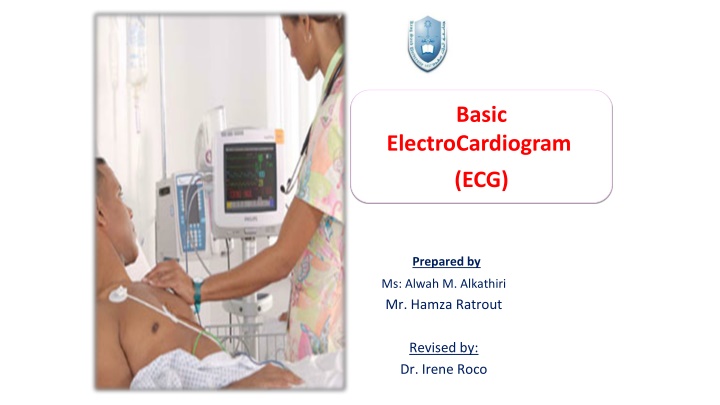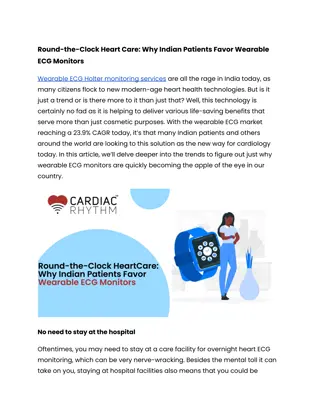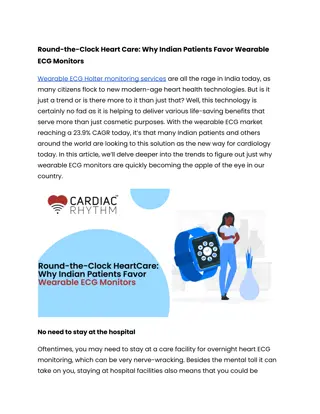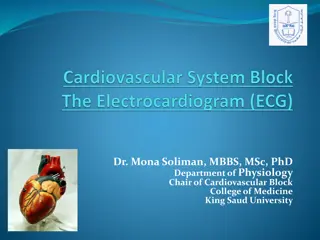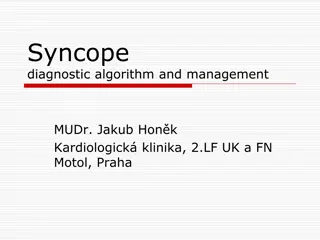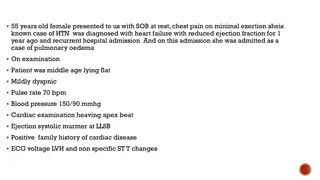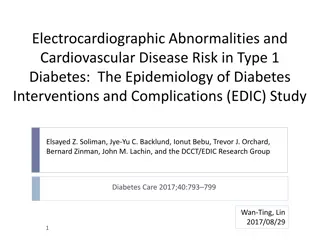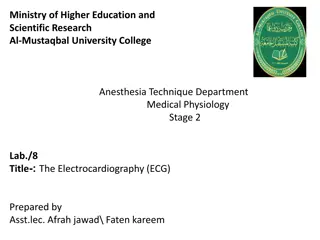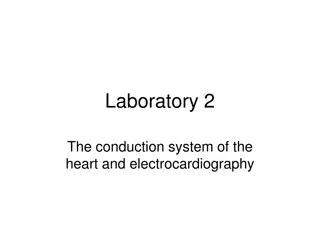Electrocardiography (ECG): Basics and Clinical Considerations
Electrocardiography (ECG) is a vital tool for recording the heart's electrical activity. This article covers the definition of ECG, cardiac conduction system, reasons for performing ECG, types of leads, stress ECG, continuous ECG, preparation, electrode placement, and important clinical considerations. ECG involves detecting tiny electrical changes in the skin representing heart muscle activity during each heartbeat.
Download Presentation

Please find below an Image/Link to download the presentation.
The content on the website is provided AS IS for your information and personal use only. It may not be sold, licensed, or shared on other websites without obtaining consent from the author.If you encounter any issues during the download, it is possible that the publisher has removed the file from their server.
You are allowed to download the files provided on this website for personal or commercial use, subject to the condition that they are used lawfully. All files are the property of their respective owners.
The content on the website is provided AS IS for your information and personal use only. It may not be sold, licensed, or shared on other websites without obtaining consent from the author.
E N D
Presentation Transcript
Basic ElectroCardiogram (ECG) Prepared by Ms: Alwah M. Alkathiri Mr. Hamza Ratrout Revised by: Dr. Irene Roco
Outline of lecture; Definition of ECG Cardiac Conduction System Reasons for Performing ECG Types of Leads ( 12, 15, 18 Leads) Types of ECG (Stress ECG, Continuous ECG Important Clinical Consideration Preparation Placement of electrodes References
Electrocardiography (ECG or EKG*) the process of recording the electrical activity of the heart over a period of time using electrodes placed on a patient's body.
Electrocardiography (ECG or EKG*) These electrodes detect the tiny electrical changes on the skin that arise from the heart muscle depolarizing during each heartbeat.
Cardiac Conduction System Cardiac Conduction System Anatomical orientation: Figure 1: (Marquette Electronics, 1996) (From: Yanowitz, FG. The Alan E Lindsay ECG Learning Centre in Cyberspace [homepage on the Internet]. c2012. Available from: http://library.med.utah.edu/kw/ecg/index.html.)
Electrical Conduction System Depolarization that starts with pacemaker cells in the sinoatrial node, spreads out through the atrium, atrioventricular node Bundle of His Right and Left Bundle Branches Purkinje fibers spreading down and to the left throughout the ventricles.
ECG Graph Paper ECG Graph Paper Voltage 0.04 seconds (millivolts; mV) y (1 1) mm2 0.1 mV x x Time (seconds; s) Question: What would the bigger square, i.e. the (5 5) mm2, represent? Answer: 0.2 seconds. y
Electrocardiography (ECG or EKG*) In a conventional 12 lead ECG, ten electrodes are placed on the patient's limbs and on the surface of the chest recorded over a period of time (usually 10 seconds). A typical ECG tracing is a repeating cycle of three electrical entities: a. a P wave (atrial depolarization) b. a QRS complex (ventricular depolarization) c. a T wave (ventricular repolarization).
Types of Leads used in Obtaining ECG 1. Standard 12 Lead Most commonly used tool to diagnose: Dysrhythmias Conduction abnormalities Enlarged heart chambers Myocardial ischemia or infarction High / low calcium and Potassium level Effects of some medications
Types of Leads used in Obtaining ECG 2. 15 Lead ECG 3 chest leads are added across the right precordium A valuable tool for early diagnosis of Right ventricular and posterior left ventricular infarction
Types of Leads used in Obtaining ECG 3. 18 Lead ECG 3 chest leads are added from the 15 lead ECG Early detection of Myocardial Ischemia and injury
ECG measures the following: rate and rhythm of heartbeats the size and position of the heart chambers the presence of any damage to the heart's muscle cells or conduction system the effects of cardiac drugs the function of implanted pacemakers.
Reasons for performing electrocardiography include: 1. Suspected heart attack 2. Suspected pulmonary embolism 3. A third heart sound, fourth heart sound, a cardiac murmur or other findings to suggest structural heart disease 4. Perceived cardiac dysrhythmias
Reasons for performing electrocardiography include: 5. Fainting or collapse 6. Seizures 7. Monitoring the effects of a heart medication 8. Assessing severity of electrolyte abnormalities, such as hyperkalemia
Types of ECG 1. Stress Electrocardiography Uses ECG to assess the client s response to an increased cardiac workload during exercise using treadmill or stationary bicycle
Stress Electrocardiography Goal of this test: to increase the heart rate to the target rate Client with Coronary artery disease may develop chest pain and characteristic ECG changes during exercise
When to Terminate Stress Test 1. When Target heart rate is achieved 2. When patient experiences symptoms / complications: Chest pain Extreme fatigue Decrease in BP/ PR Serious dysrhythmia or ST segment changes in ECG
Nursing Responsibility for Stress Electrocardiography Monitor : Two or more ECG leads for HR, rhythm and ischemic changes BP Skin temperature Physical appearance Perceived exertion Symptoms ( chest pain, dyspnea, dizziness, leg cramping, fatigue)
2. Continuous Electrocardiographic Monitoring Standard for patients who are at risk for dysrhythmias Patients should be informed that this monitoring will not detect symptoms such as dyspnea or chest pain, therefore, patients need to be advised to report symptoms to the nurse whenever they occur
Important clinical considerations Important clinical considerations Correct lead-placement and good skin contact are essential. Avoid electrical interference (machine to be earthed). Compare serial tracings, if available. Relate any changes to age, gender, clinical history, etc. Consider co-morbidities and intercurrent illnesses that may have an effect on the ECG. Obtain a photocopy for future reference. Interpret the ECG systematically to avoid errors.
Preparation 1. Ensure that the client did not receive any medication 2. Ask your pt to remove all jewelry and to wear a hospital gown 3. Usually ECG is taken while the patient is resting so ask your pt to lie down 4. Areas such as the chest where the adhesive electrodes will be placed may need to be shaved first, then skin is cleaned
Preparation 5. Avoid oily or greasy skin creams and lotions the day of the test. They interfere with the electrode-skin contact 6. Avoid full-length hosiery, as electrodes need to be placed directly on the legs. 7. Wear a shirt that can be easily removed to place the leads on the chest.
Placement of electrodes Ten electrodes are used for a 12-lead ECG. The electrodes usually consist of a conducting gel, embedded in the middle of a self-adhesive pad onto which cables clip. Sometimes the gel also forms the adhesive. They are labeled and placed on the patient's body Proper placement of the limb electrodes, color-coded The limb electrodes can be far down on the limbs or close to the hips/shoulders, but they must be even (left vs right)
Electrode label RA LA RL LL Electrode placement On the right arm, avoiding thick muscle. In the same location where RA was placed, but on the left arm. On the right leg, lateral calf muscle. In the same location where RL was placed, but on the left leg.
Instruct patient to be calm and no movement, Then print the result The test is completely painless and takes less than a minute to perform once the leads are in position. After the test, the electrodes are removed & clean the skin
References Brunner & Suddarth s Medical Surgical Nursing. 10th ed Kozier & Erbs Fundamentals of Nursing . Eighth ed. 2008
